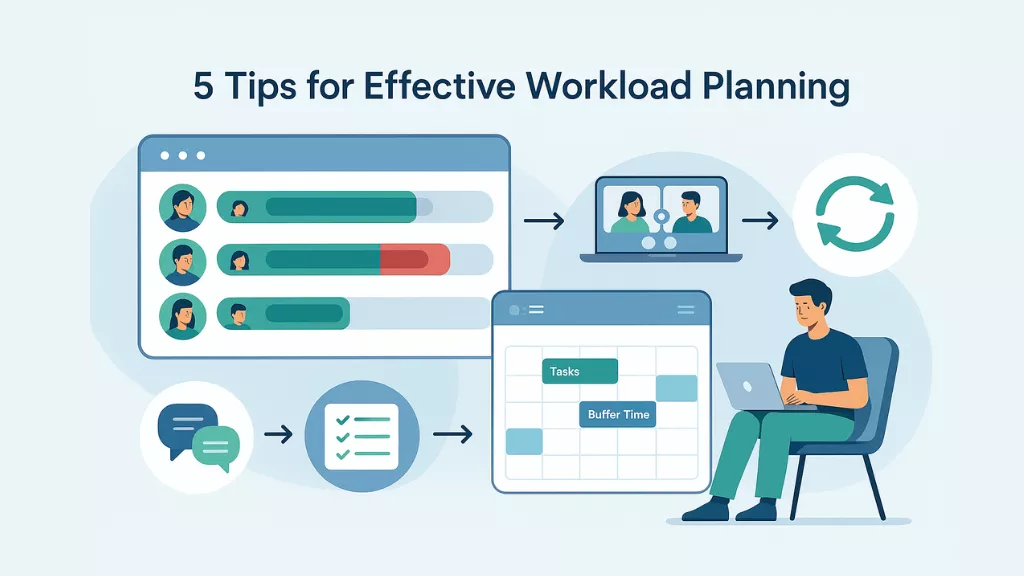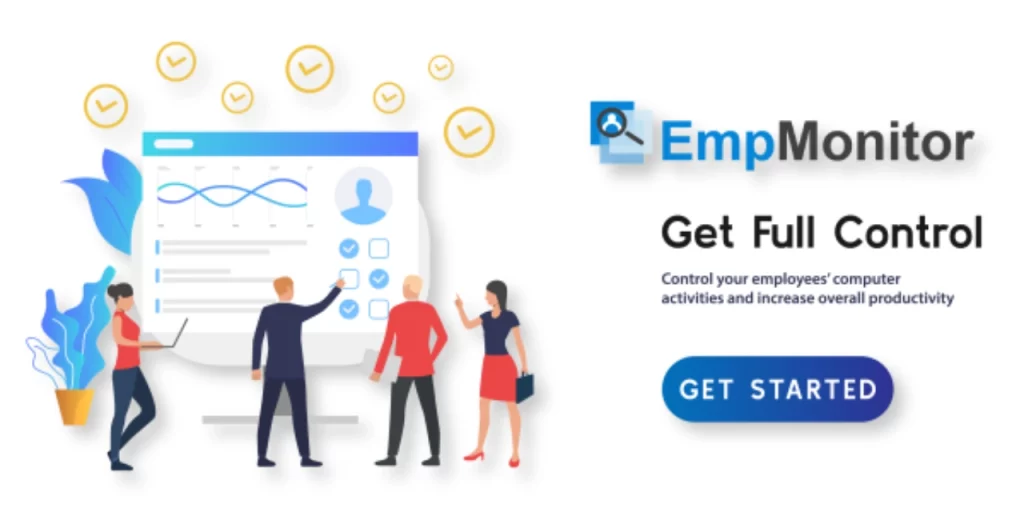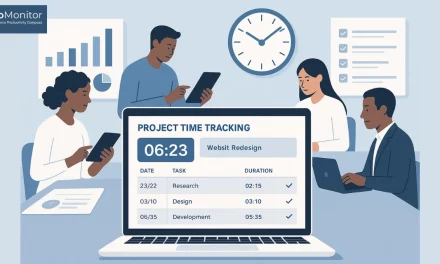Whether you work as a resource manager, project lead, or business owner, ensuring your team members aren’t overworked and bored is a large portion of your job description. With so many components, workload planning is a compelling challenge.
Workload planning is essential for companies to manage resources effectively and ensure productivity. It involves assigning duties and responsibilities to people or groups in a calculated manner to accomplish goals. Organizations run the danger of inefficiency, missing deadlines, and staff fatigue if they don’t organize their workload properly.
In this blog, we’ll look into what workload planning is and why workload planning tools are necessary for your company. So, let’s begin.
Hit ‘Play’ Button & Tune Into The Blog!
What Do You Mean By Workload Planning?
Workload planning, also referred to as workload management, is a calculated strategy for optimizing your team’s output so that your objectives are reached. As a key component of human resource planning, it ensures that tasks are allocated efficiently based on team capacity and skills.
Workload planning, also called workload management, is more than just assigning tasks—it’s a strategic approach to ensure your team can deliver efficiently without feeling overwhelmed. At its core, workload planning involves breaking down large projects into smaller, manageable tasks, then assigning them based on each team member’s skills, capacity, and availability.
This process isn’t static. As projects progress and team dynamics shift, workload planning requires continuous monitoring and adjustment. For example, a team member may become temporarily unavailable due to time off, or a high-priority task may arise that demands immediate attention. By regularly refining task assignments and schedules, managers can maintain a balanced workload, prevent burnout, and ensure projects stay on track.
In practice, effective workload planning helps managers answer key questions:
-
Who is best suited for this task based on their expertise?
-
Does anyone have the capacity to take on additional responsibilities?
-
Are timelines realistic given current workloads and upcoming absences?
By addressing these questions and adjusting workloads dynamically, organizations can optimize resources, enhance productivity, and support a motivated, engaged team.
Importance of Implementing Workload Planning Tools
Workload planning tools enable better work-life balance among team members, more effective task prioritization, and more precise project scheduling. Let’s undercover the reason why implementing workload planning is vital for companies.
Increasing Employee Satisfaction and Engagement
Employee engagement and job satisfaction are higher when they believe that their workloads are reasonable and that their efforts are valued. Workload planning tools effectively involve taking into account each team member’s preferences and skill set, which enables managers to assign work that plays to each member’s interests and talents. This promotes employee loyalty and retention in addition to increasing job happiness.
Fulfilling Deliverables and Deadlines
Timelines and deliverables are routinely fulfilled when the workload is effectively planned. Managers can avoid bottlenecks and delays in project completion by allocating activities based on available resources and reasonable timescales. This strengthens the organization’s reputation for producing high-quality work on schedule by fostering an environment of accountability and dependability.
Avoiding Stress and Burnout
Preventing stress and burnout in employees is one of the biggest advantages of task planning. Overworked personnel may experience a drop in productivity, higher absenteeism, and lower morale. Managers may encourage a healthy work-life balance and lower the risk of burnout among their teams by allocating workloads fairly and setting reasonable objectives.
Fostering Collaborations and Communications
Project management tools encourage cooperation and communication within teams as well as between departments. Managers can promote more collaboration and coordination among team members by outlining roles, duties, and expectations in detail. This promotes creativity, cross-functional problem-solving, and knowledge exchange, all of which benefit the organization as a whole.
Optimizing Resource Allocation
Planning the workload enables firms to deploy resources effectively. Managers can allocate resources appropriately and guarantee that every project receives sufficient attention and assistance by evaluating the requirements of different activities and projects. This keeps some teams or individuals from being overworked while others go unutilized, which improves resource utilization and production.
Read More:
WHY IS PERFORMANCE MONITORING IMPORTANT | 09 BEST PRACTICES
HOW TO STREAMLINE YOUR PERSONAL WORKLOAD MANAGEMENT PROCESS
HOW TO MANAGE WORKLOAD PLANNING IN 7 STEPS
5 Tips for Effective Workload Planning
Effective workload management strategies are essential to the success of any firm. Let’s understand the five best practices for planning the workload effectively.
Effective Workload Planning isn’t just about assigning tasks; it’s about creating an environment where your team can thrive, collaborate, and remain productive without burnout. Here are some practical strategies to help you plan and manage workloads efficiently:
1. Keep utilization under 80%
Overloaded team members can quickly lead to errors, missed deadlines, and stress. A healthy target for individual utilization is 70–80%. This ensures employees have room to handle urgent tasks, creative work, and unexpected challenges without feeling overwhelmed.
2. Build buffer time into schedules
Even with careful Workload Planning, projects rarely go exactly as expected. Allocate time for unforeseen delays, revisions, or urgent issues. This proactive approach prevents bottlenecks and reduces last-minute pressure on your team.
3. Sync calendars for visibility
Integrate team calendars into your project management system. Doing so gives managers a clear picture of availability, prevents double-booking, and ensures assignments are realistic. Team members can see deadlines and dependencies, promoting transparency and accountability.
4. Communicate expectations clearly
Clearly define priorities, deadlines, and performance levels. When everyone understands what “good enough” looks like versus high-priority deliverables, teams can focus on achieving results efficiently. Communication reduces confusion and helps prevent overwork.
5. Support remote and hybrid teams
Remote teams require additional attention to workload visibility and engagement. Trust your team to manage their schedules while using tools that allow real-time tracking and collaboration. This balance maintains accountability without micromanagement and helps keep morale high.
6. Continuously review and adjust
Workload Planning is not a one-time activity. Regularly check progress, gather feedback, and redistribute tasks as needed. Dynamic adjustment ensures projects stay on track, resources are optimized, and team members remain motivated and stress-free.
By following these best practices, managers can make Workload Planning a sustainable and human-centered process, improving productivity, collaboration, and team well-being.
It is simpler to keep track of work status, visualize the project timeline, and manage personnel capacity and usage in real time when all of this information is easily accessible and in one dashboard. One such project management tool is EmpMonitor. Let’s learn more about this in detail.
EmpMonitor – The Workforce Management Software
EmpMonitor is a robust and reliable employee monitoring tool that can monitor your workforce, helping you track the employees’ computer activity.
With over 500k+ employees tracked across 100+ countries, EmpMonitor serves its features across various business aspects like IT Industry, Banking, Healthcare, Education, etc. It provides some key features like monitoring team performance, managing a distributed workforce & enhancing security measures that help increase productivity at work.
Considering the necessity of workload planning, EmpMonitor offers a variety of features.
Task Handling and Subtask Creation
This workforce management software manages tasks with CRUD(Create, Read, Update, and Delete) operations effortlessly, including fetching, searching, filtering, and generating reports.
Moreover, it breaks down the tasks into subtasks for unparalleled project control and tracking, ensuring no detail is overlooked.
Project Management
EmpMonitor helps you to assign tasks to your team, monitor their work, and manage the entire project from start to end. It lets you get a clear picture of the project work, ensuring the team is productive and in the right direction.
Productivity Tracking
This software delivers visibility into the employee working hours, helping you get a clear view of whether employees are proactively engaged while being productive. The in-depth categorized data of employee working hours, productivity, and ideal hours will help you increase workflow efficiency and create a well-functioning team to meet your business’s target goals.
Automated Reports
EmpMonitor is a workforce management software that provides detailed time reports and actionable insights with the help of advanced timesheets contributing to the company’s growth. It also helps in maintaining payroll data and accurate billing.
Conclusion
Organizing your workload allows you to use resources within your team or company more effectively. It also improves engagement and productivity while lowering staff stress and burnout.
By implementing workload planning tools like EmpMonitor, businesses can streamline the process, ensure balanced workloads, and monitor progress effectively. With features such as task handling, project management, productivity tracking, and automated reports, EmpMonitor provides a comprehensive solution for team workload planning. By utilizing such project management tools, organizations can achieve greater efficiency, productivity, and success in their projects. So, start utilizing a team workload planning template like EmpMonitor today and take your workload planning to the next level.
















